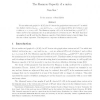Free Online Productivity Tools
i2Speak
i2Symbol
i2OCR
iTex2Img
iWeb2Print
iWeb2Shot
i2Type
iPdf2Split
iPdf2Merge
i2Bopomofo
i2Arabic
i2Style
i2Image
i2PDF
iLatex2Rtf
Sci2ools
COMBINATORICA
1998
1998
The Shannon Capacity of a Union
For an undirected graph G = (V, E), let Gn denote the graph whose vertex set is V n in which two distinct vertices (u1, u2, . . . , un) and (v1, v2, . . . , vn) are adjacent iff for all i between 1 and n either ui = vi or uivi ∈ E. The Shannon capacity c(G) of G is the limit limn→∞(α(Gn ))1/n , where α(Gn ) is the maximum size of an independent set of vertices in Gn . We show that there are graphs G and H such that the Shannon capacity of their disjoint union is (much) bigger than the sum of their capacities. This disproves a conjecture of Shannon raised in 1956.
| Added | 21 Dec 2010 |
| Updated | 21 Dec 2010 |
| Type | Journal |
| Year | 1998 |
| Where | COMBINATORICA |
| Authors | Noga Alon |
Comments (0)

